Crypto Academy / Season 3 / Week 1 - Homework Post for @imagen
STAKING
Staking is a way by which one gets CRYPTOCURRENCY as reward for locking ones asset for a particular period of time. This can be done either through a wallet or an exchange that offers staking. Staking doesn't make use of complex hardwares or mathematical computation, stakers are rewarded based on the amount of crypto they stake at that time and the period at which they are staking for it can be a day, a week or even months.
The staker with a larger stake gets the largest reward this is because in staking the stakers are been chosen at interval to be the next block validator, We will be looking at some platforms that allows stakers to stake their crypto for reward.
KUCOIN

Kucoin was founded by Michael Gan and Eric Dan with 6 other core team members. It was officially launched in 2017 but the exchange architecture was created in 2013. Kucoin is a fast rising global cryptocurrency exchange platform with several coins and over 40p trading pairs. It is a good platform for traders both old and new. This platform provides traders with lot of features which staking is one of them.
KUCOIN STAKING
Kucoin is the first platform to launch a soft staking method. Soft staking is a mechanism that allows stakers to receive their rewards on a daily basis without having to wait for several months or days. This mechanism also makes stakers fund unlock which means they can decide to stop the staking any day and Any time. This process was introduced in July 2019.
Soft staking allows more flexibility and more compounding for stakers.
Kucoin platform has 4 different features for their staking, which we will review below.
To access the kucoin staking platform, one can either use the web version or the application veruson which I will be using in this lesson.
After registration, open your app, you will find all the features of the app on the homepage then click on staking.
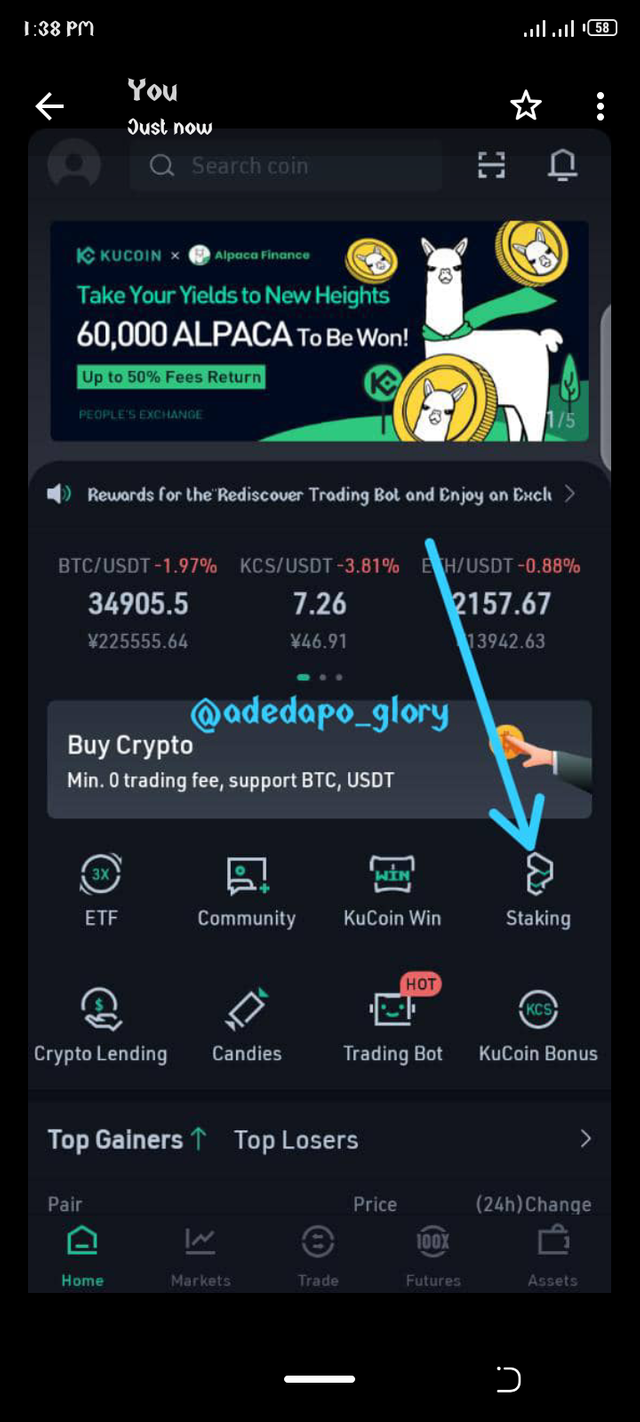
After clicking the staking button it will lead you to the features under staking. Which brings us to the first feature
HOT.

Hot provides you with the top and most recent coin which one can stake on. As at the time of this review there are only 2 coin available for staking under hot. It is a 7 day annual yield with the flexible mechanism.
According to KSM staking. If a staker stakes some certain amount of the coin after 7 days the staker gets 6.25% × 7/365 × the amount of asset used.
For example if a staker staked 49 KSM the amount of KSM the staker gets at the end of 7 days is
6.25/100 × 7/365 ×100 = 0.0625 × 0.019 × 49
Reward = 0.058KSM. which means he gets 0.008 KSM per day.
FLEXIBLE
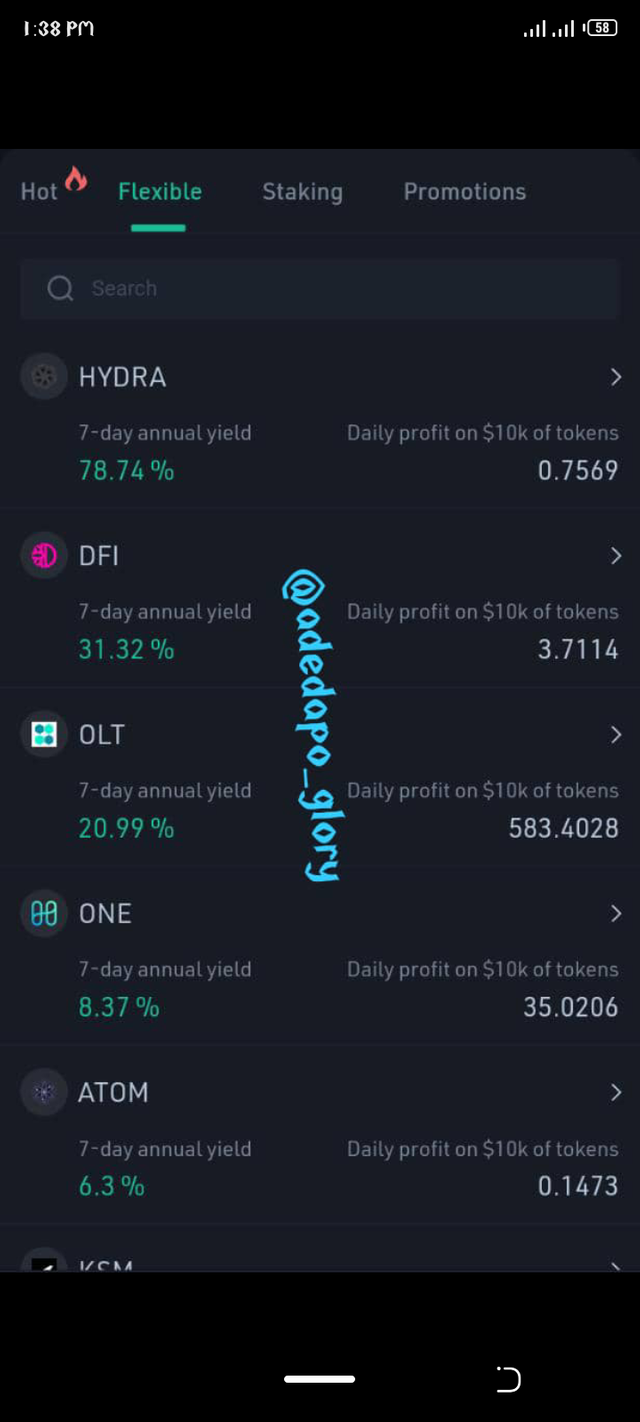
This is another feature under kucoin staking where there are lot of coins to stake on but on this feature all are flexible coin which is just a 7 day lock coin, but a staker can withdraw his or her reward daily.
STAKING
Under this feature we have varieties of coin to stake on and with various time frame.
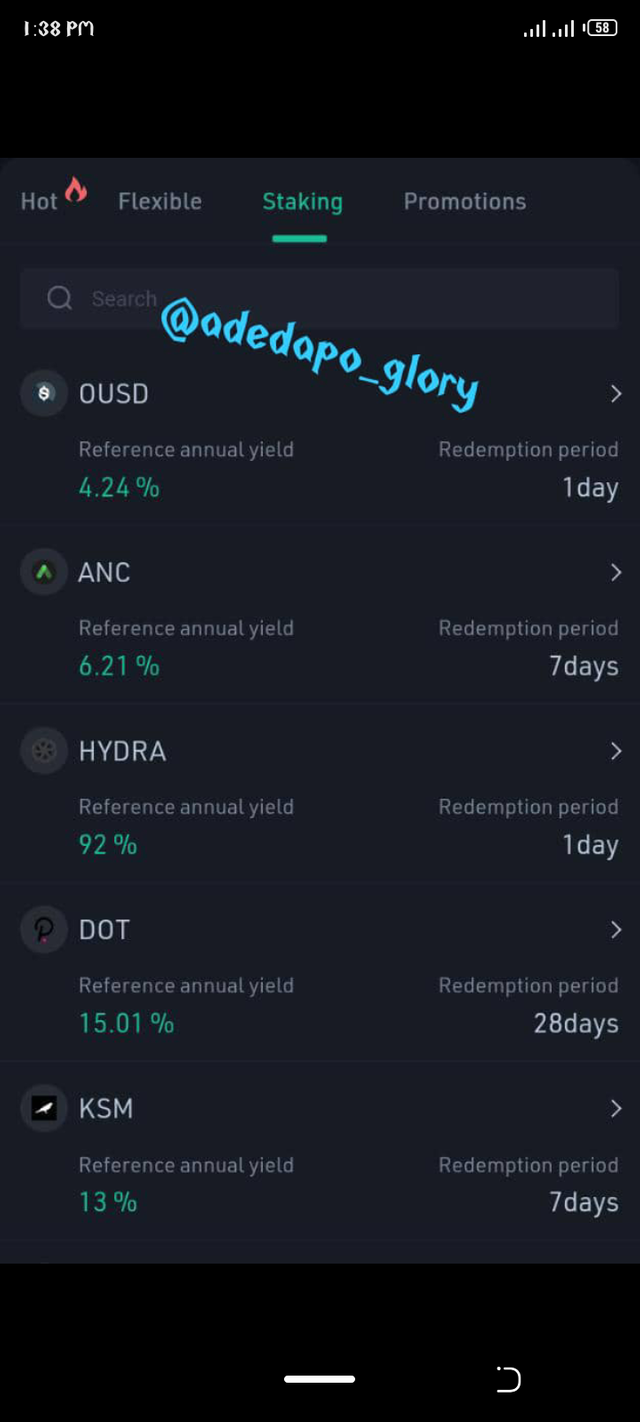
This has coin of various blockchain and provides high annual percentage yield.
PROMOTION
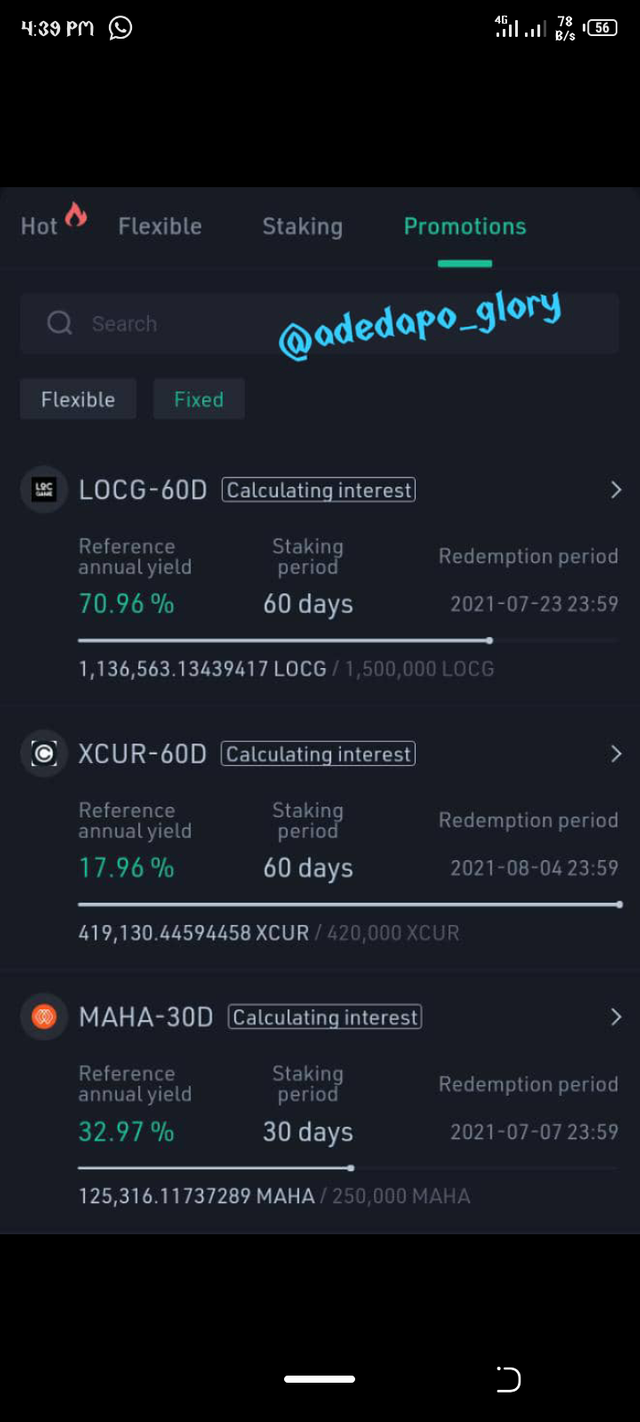
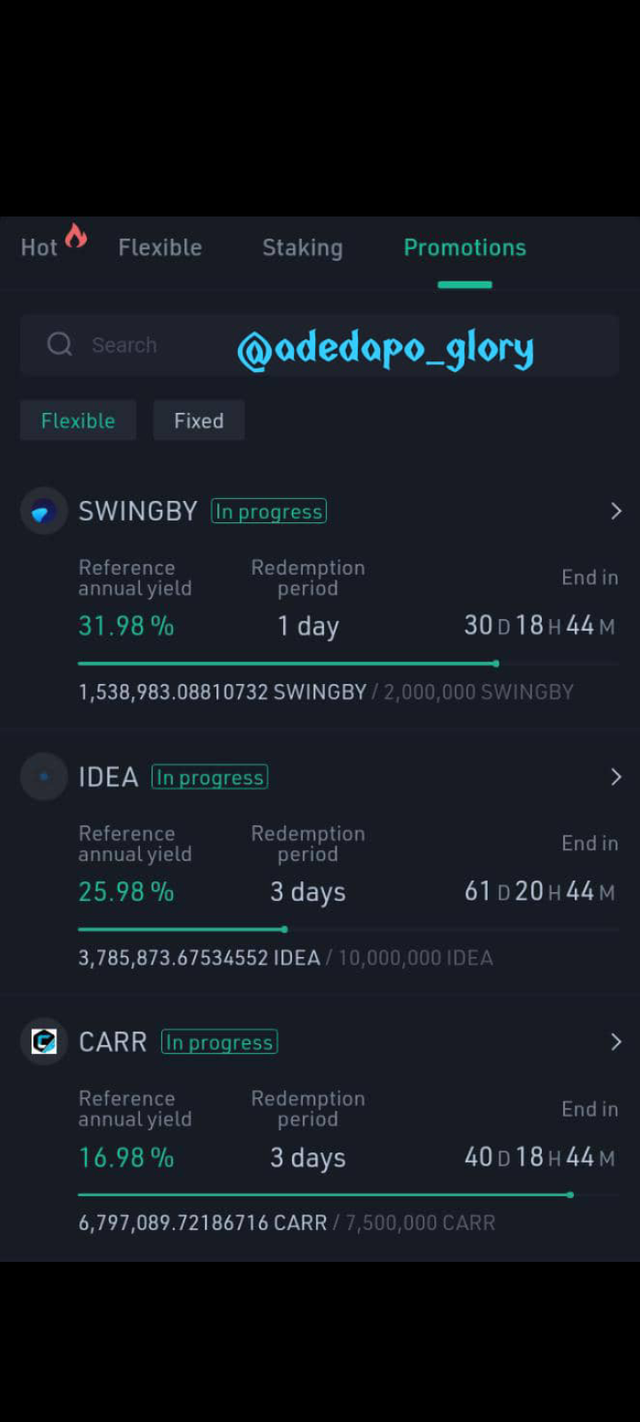
This promotion is a feature for some certain coin that wants to Airdrop their coin to their holders. This promotion is in two ways, the fixed which takes up to 60 days and the flexible which maximum is 7 days.
POLONIEX

Poloniex is an exchange platform that was founded in 2013 but due to various issue on the platform the users has decreased significantly.
STAKING ON POLONIEX
Staking on poloniex is very simple anyone who wishes to stake just have to buy and deposit the tokens available for staking on the poloniex platform and a snapshot will be taken at interval which then gives rewards to stakers.
Poloniex staking offers no locking period of asstes. The assets that can be staked on Poloniex are mainly Tron based asset like TRON, BTT, WINk and ATOm.
Staking rules
ATOM: A staking fee of 25% is taken from the staker and the minimum stake is 1 ATOM, and the users get daily rewards.
25% staking fee
TRON (TRX): there is no fee for staking Tron but the minimum value to stake is 100 TRX, snapshot is taken 4 times a day and the reward is distributed twice in a week
BitTorrent (BTT): Minimum stake for BTT is a thousand BTT, 4 snapshot daily and reward is distributed twice a week.
WINk (WIN): minimum of 5000 Win is deposited, the snapshot is 4times a week and twice a week distribution of rewards.
Kucoin vs Poloniex
Accorindg to the reviews above kucoin is known for its free of hack record unlike poloniex which has been hacked on different occasions.
Kucoin offers staking on more than 10 different assets with soft staking features, locked features and also gives stakers to earn other coin. Poloniex mainly allows staking of Tron based project which will not be a good platform for those who doesn't deal with Tron projects.
Kucoin might be the best staking platform for investors who uses various blockchain with a very high APR for it's stakers. Kucoin is a more better staking platform than Poloniex in my opinion.
IMPERMANENT LOSS
When liquidity is provided to a liquidity pool by a liquidity provider and the price of the assets used a liquidity changes to the deposit price it is called an impermanent loss. The change is irrespective of whether it is a decline in price or increase in price, as long as there is a change.
The bigger the change in price the higher the risk of impermanent loss.
When liquidity is provided for a less volatile asset like stable coin the risk to impermanent loss is less for the liquidity provider.
For example, if we are to provide liquidity for BNB-BUSD, we deposit 1 BNB and 100 BUSD in the pool which means that 1 BNB is equivalent to 100 BUSD so therefore we have deposited $200 to the pool. In the same vein other liquidity provider would have provided liquidity as well, so let's say a total of 10BNB and 1000 BUSD is in the pool. So we will be having a share of 10% in the liquidty.
If the price of BNB increases such that a BNB cost 400 BUSD, when this happens traders will exchange BNB for BUSD reducing the ratio of BNB to BUSD from 50% each. So the pool ratio will be 5BNB and 2000 BUSD.
If as a liquidity provider you decide to withdraw your liquidity, you can the go ahead and withdraw 0.5BNB as well as 200BUSD because you have just 10% of the shares. Which amounts to 400 BUSD you have made profit but not as much as hodling your BNB or converting your BUSD to BNB so you can have 2BNB and that would have given you a value of $800. The loss incurred is what we refer to as impermanent loss.
DELEGATED PROOF OF STAKE (DPoS).
Delegated proof of stake is an alternative method to the proof of stake consensus mechanism that was created by Daniel Larimer in 2014. After it's creation it was first used as part of bitshares blockchain and was later adopted by other network like Steem and EOS which was founded by Larimer as well.
DPoS Enables user to vote with their coin where the amount of coin a voter has is equal to the voting power.
If Voter A has 1 million coin of an asset he therefore has 1 million vote power. The user with the highest voting power are then delegated to manage the blockchain on behalf of other users ensuring security and transparency. When the rewards for staking is gotten, the delegates then share the rewards is shared amongst the delegate and his elector in ratio to the power of votes they have.
DPoS allows users to commit their coin balances as votes, where voting power is proportional to the number of coins held. These votes are then used to elect a number of delegates who manage the blockchain on behalf of their voters, ensuring security and consensus. Typically, the staking rewards are distributed to these elected delegates, who then distribute part of the rewards to their electors proportionally to their individual contributions.
Conclusion
Staking uses either a proof of stake or delegated proof of stake consensus in providing rewards for it's user and this is less energy consuming unlike the use of proof of work which consumes alot of energy. The proof of stake also doesn't allow for complex mathematical computation and this makes it easier for stakers to get rewards without stress.
As much as staking seems quite okay it should be noted that it has it own risk especially when the price of the asset used in staking is reducing drastically and the asset has been locked for a period of time,
This post contains Plagiarized Content
Sources:
@sapwood
Am sorry professor I didn't know